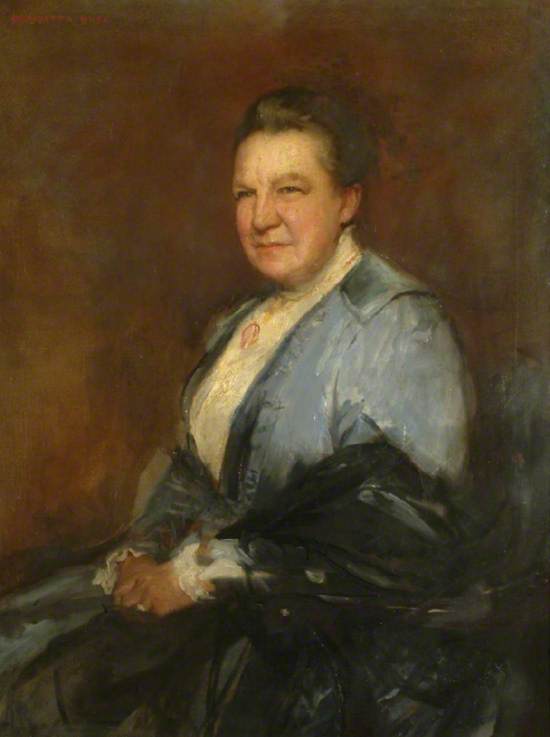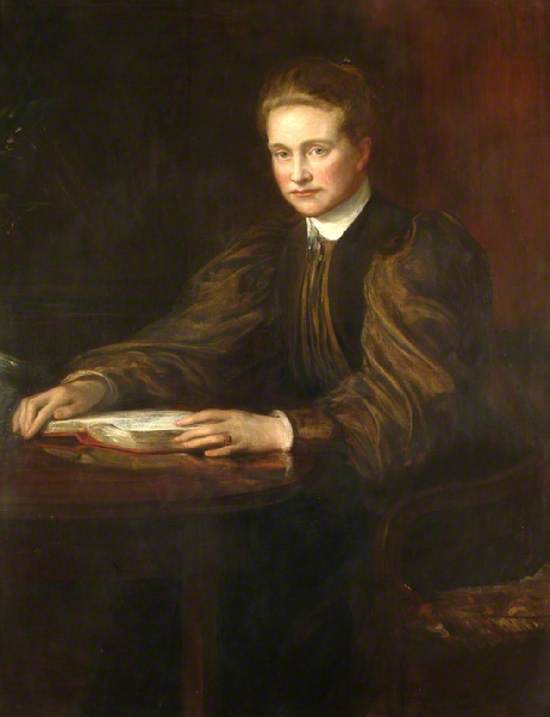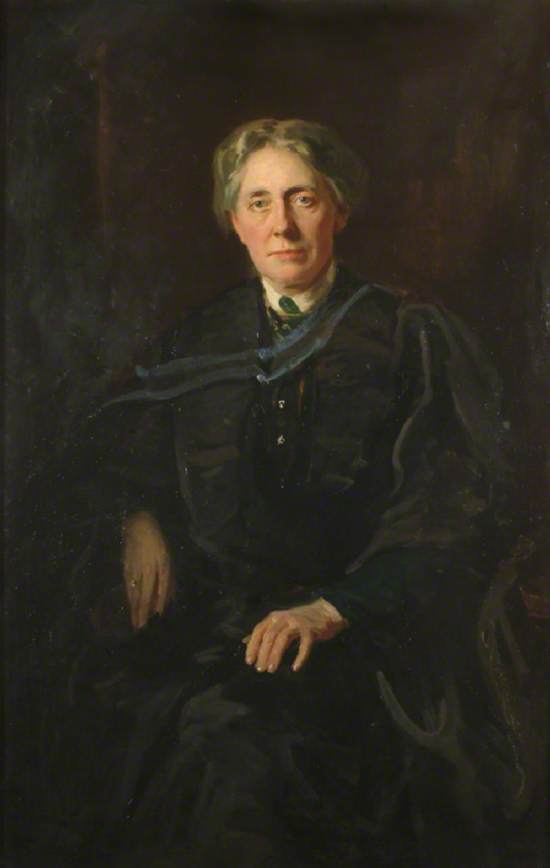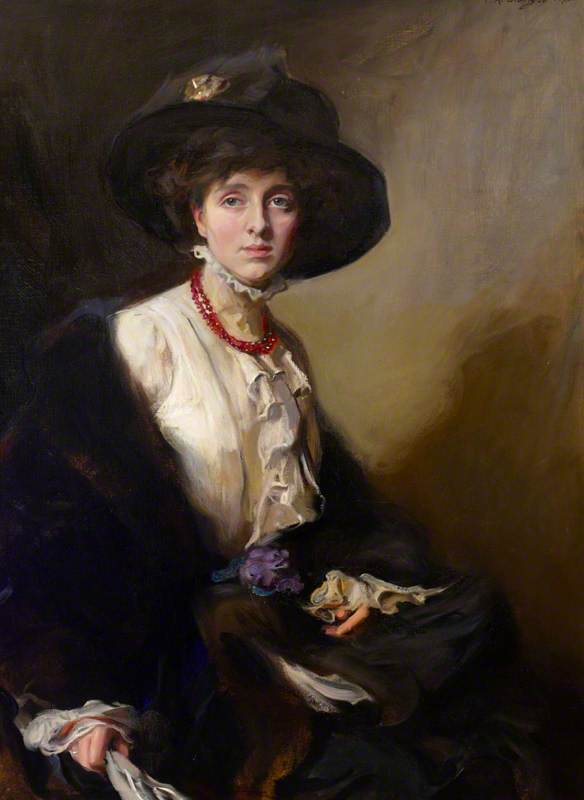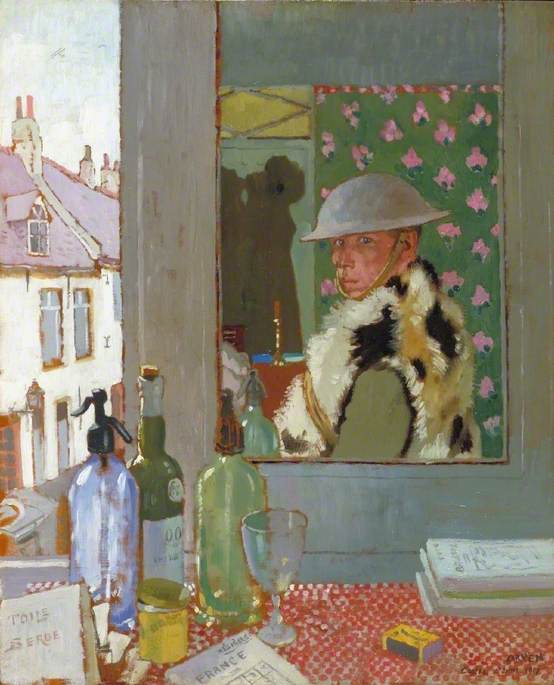This exhibition explores portraits of the women who were pioneers in positions of leadership at Bedford and Royal Holloway Colleges, two of the first institutions offering women a university-level education in Britain. When Royal Holloway College and Bedford College merged in 1985, their portraits came together to form a unique collection, a visual realization of the intersection between the history of women’s higher education and the development of modern portraiture.
Bedford College
Bedford College, founded by Elizabeth Jesser Reid (1789-1866) at 47 Bedford Square in 1849, was one of the first higher education colleges for women in the United Kingdom. The college moved to York Place, off Baker street in 1874, and in 1878 Bedford students were among the first women to gain degrees after the University of London opened degree examinations to women. Bedford College did not appoint a Principal until 1893. Bedford College’s earlier portraits reflect this as they depict leading figures in suffrage and women’s education who were associated with Bedford College, such as Henrietta Busk and Millicent Garrett Fawcett. This collection was later supplemented by commissioned portraits of the college’s Principals.
Henrietta Busk
Henrietta Busk, an educationalist and local politician, made an extraordinary contribution to the early life of Bedford College. Her mother, Mary Ann Busk, was one of the founders of the College in 1849, and Henrietta, who studied there, was the first student to receive the Reid Scholarship. She served on the Bedford College Council in 1882-85 and 1889-1936, and founded the Bedford College Students Association in 1894.
Percy Bigland, a founder member of the New English Art Club, painted several other leading figures in the cause for women’s higher education, such as Professor Caroline Skeel, Reader in Classics at Westfield College, and Elizabeth Powell Bond, Dean of Swarthmore College, an early coeducational college in the United States.
Percy Bigland (1858–1926)
Oil on canvas
H 101.6 x W 76.2 cm
Royal Holloway, University of London
Millicent Garrett Fawcett
The sitter in this portrait has recently been identified as Millicent Garrett Fawcett, the leading suffragist and political activist, who was also a prominent campaigner for women’s education. She was a great friend to Bedford College, which her daughter Philippa attended, and addressed the students of the College on several occasions.
Fawcett sits in a dark interior, looking up as if interrupted at her reading. Wirgman had successfully employed this traditional convention to portray scholars at work in a series of portraits of male sitters for the Graphic magazine in the 1880s. Wirgman exhibited this portrait at the Royal Academy summer exhibition in 1898 and it was given to Bedford by his aunt, a friend and supporter of Fawcett.
Theodore Blake Wirgman (1848–1925)
Oil on canvas
H 111.2 x W 86.5 cm
Royal Holloway, University of London
Margaret Janson Tuke
Margaret Janson Tuke was the longest serving Principal of Bedford College (1907-29). Although she had gained a First in Modern and Medieval Languages at Newnham College, the University of Cambridge did not grant degrees to women students until 1948. This portrait depicts her in the blue-lined hood and black gown of an MA graduate of Trinity College Dublin, which had agreed to award degrees to women who completed Oxbridge courses.
This portrait was commissioned to honour Tuke’s role in moving Bedford College to new premises in Regent’s Park in 1913. The artist, who lived nearby, was chosen by Tuke herself, but she did not like the portrait very much, and in 1933 the college decided to commission a second picture of its now retired Principal
Reginald Grenville Eves (1876–1941)
Oil on canvas
H 122 x W 78 cm
Royal Holloway, University of London
Sketch of Margaret Janson Tuke
This half-length painting is a preliminary study for Eves’ finished three-quarter length portrait of Margaret Tuke, Principal of Bedford College. Further donations to the subscription fund, after the price of the portrait had been agreed, allowed the portrait committee to purchase the study as well. It was given to Tuke, who duly presented it to the College.
Eves’ loose brushwork draws attention to the movement of the folds and pleats of the sitter’s gown. Her high white collar, simply arranged hair, Bedford green tie and buttoned waistcoat contribute to the masculine look favoured by many female scholars of the time. Eves does not include the delicately placed hands which lighten and animate the finished portrait.
Reginald Grenville Eves (1876–1941)
Oil on canvas
H 75.5 x W 62.5 cm
Royal Holloway, University of London
Margaret Janson Tuke
This portrait strikingly draws on the conventions of Renaissance portraiture. The fictive marble parapet bears a trompe l’oeil letter with the artist’s signature. The green curtain hanging in the background and the sitter’s fur collar recall the work of Hans Holbein. The format was particularly appropriate for Dame Margaret Tuke, who had studied modern and medieval languages at Cambridge and who later gave Bedford College library a group of 16th-century Italian manuscripts related to the Peruzzi family. The early 18th-century carved Italian frame matches the Renaissance style.
Dodd’s portrait of Margaret Tuke was the second commissioned by Bedford College, but like the earlier portrait by Eves, was not thought to be a very good likeness.
Francis Dodd (1874–1949)
Oil on canvas
H 63.5 x W 50.8 cm
Royal Holloway, University of London
1952

Geraldine E. M. Jebb
Geraldine or ‘Gem’ Jebb lectured in Economics at Cambridge and Newcastle before being appointed Principal of Bedford College (1930-51). As war-time Principal, she oversaw Bedford College’s evacuation to Cambridge in 1939, and the restoration of its bombed London buildings.
Resting her cheek on her hand, Jebb appears to be listening to the person opposite her. Her checked mauve suit and the pale green background nod to the colours both of Bedford College and the women’s suffrage movement.
Gunn’s naturalistic style and attention to detail made him a popular choice among patrons with more conservative tastes. He undertook a number of commissions for other women’s colleges, including Somerville College, Lady Margaret Hall and Newnham College.
Herbert James Gunn (1893–1964)
Oil on canvas
H 111.8 x W 91.5 cm
Royal Holloway, University of London
Royal Holloway College
Royal Holloway College was founded by philanthropist Thomas Holloway in 1879 and opened by Queen Victoria in 1886. Holloway took advice from Millicent Fawcett, Dr Elizabeth Garrett Anderson, Maria Grey, and Emily Davies, who had founded Girton College, Cambridge, in 1869. Holloway tried, unsuccessfully, to persuade the latter to become his first Principal, a position of utmost importance at Royal Holloway. The College’s pride in its principals is attested by their portraits, which were commissioned from the most celebrated artists of the day. These portraits were hung in the College dining hall, where the resident students would process in to formal dinner every night, an unusual custom among the early women’s colleges.
Matilda Ellen Bishop
Matilda Bishop was the first Principal of Royal Holloway College. She had studied at Queen’s College, Harley Street, and was previously Headmistress of Oxford High School. She was staunchly Anglican, and resigned when it was suggested the college chapel should hold Nonconformist services.
Bishop looks up at the viewer with a direct gaze, wearing an elaborate black satin tea gown, and holding a spray of pink roses, the college emblem she chose. The painting was commissioned from James Jebusa Shannon, a well-known society portraitist, who emphasises Bishop’s ladylike respectability. He seems to have had sympathy with women’s education, and painted many leading figures of the movement.
James Jebusa Shannon (1862–1923)
Oil on canvas
H 125.7 x W 101.6 cm
Royal Holloway, University of London
Emily Penrose
Emily Penrose was a pioneering leader in the campaign for women’s higher education. She was the first Principal of Bedford College (1893-98), Principal of Royal Holloway College (1898-1907) and Principal of Somerville College, Oxford (1907-26). It was as a result of her determined work that both Bedford and Royal Holloway Colleges became part of the University of London in 1900, and her skills as a strategist, administrator and scholar saw Oxford women awarded degrees in 1921.
Philip de László painted a number of women educationalists. His portrait of Penrose is the first of a new portrait type he developed, in which women wore their academic gowns with the hood draped gracefully across the body, emulating neoclassical portraits.
Philip Alexius de László (1869–1937)
Oil on canvas
H 116.8 x W 91.5 cm
Royal Holloway, University of London
Sketch of Emily Penrose
Emily Penrose was unusually tall and striking. She later reported that after her preliminary sitting for this portrait, the artist remarked to his wife ‘I think I shall do it: I like her Bones’.
De László was famous for his conversation with his sitters, inviting them to speak in order to bring their expressions to life. He explained: ‘It is my task to discover the character of the sitter and transfer it to the canvas. If it does not reflect the real inner spirit, the true person, it is not a good portrait.’
He approached his portrait sittings by setting out the features and colour scheme in the first sitting. This oil sketch plans out the composition’s colours, with the balance of Penrose's blue eyes and academic hood.
Philip Alexius de László (1869–1937)
Oil on canvas
H 34 x W 24.3 cm
Royal Holloway, University of London
Elizabeth Maude Guinness
Elizabeth Maude Guinness was appointed Royal Holloway College’s first Vice-Principal in 1899, under Emily Penrose. After receiving an honorary English degree as one of the college’s earliest students, she joined the teaching staff as Librarian and later Lecturer in English. She performed her duties as Vice-Principal with great flair, inspiring admiration among the students.
Guinness was the second cousin of Philip de László’s wife, Lucy, and may have suggested that he paint Royal Holloway’s portrait of Penrose. De László seems to have thought of the portraits as a pair, presenting two models of educated women: Penrose, the visionary academic, in her university gown, and Guinness the cultured intellectual, elegantly and fashionably dressed.
Philip Alexius de László (1869–1937)
Oil on canvas
H 101.6 x W 76.2 cm
Royal Holloway, University of London
Ellen Charlotte Higgins
Ellen Charlotte Higgins was the longest-serving Principal of Royal Holloway College (1907-35). Fondly known as ‘The Chief’, Higgins had also been a student at the College. In this painting she wears her academic gown, with a University of London Arts MA hood over a shirt and tie.
The painting was commissioned from celebrated society portraitist Sir William Orpen to celebrate Higgins’ 20th year as Principal. Her standing stance, with hand on hip and mortarboard under her arm, is unusual in Orpen’s work, and recalls the conventions of military portraiture. The idea perhaps originated with Higgins herself, who would have been familiar with Philip de László’s standing portrait of Emily Penrose, her predecessor as Principal.
William Orpen (1878–1931)
Oil on canvas
H 125.7 x W 101.6 cm
Royal Holloway, University of London
Janet Ruth Bacon
Janet Ruth Bacon lectured in Classics at Girton College, Cambridge, before her appointment as Principal of Royal Holloway College (1935-44). Known to the students as ‘Ham’, she led the College’s War Work Committee during World War Two, but resigned in 1944 when it was decided to admit male students. One of her last acts was to prevent the sale of the then-unfashionable College picture collection, arguing it could be ‘a powerful factor’ in the reassessment of Victorian painting.
This painting is typical of Jagger’s acclaimed yet conservative portraits. Bacon’s academic hood and gown, rather than referring to her degree, indicate her role in the University of London Convocation, the body of graduates involved in the university’s governance.
David Jagger (1891–1958)
Oil on canvas
H 76.2 x W 63.5 cm
Royal Holloway, University of London
Acknowledgements
On behalf of Royal Holloway, University of London, I am immensely grateful to Dr Imogen Tedbury who undertook the valuable research for this project which has included authoring the catalogue to accompany this exhibition and working on three new films about these important women. I would also like to thank the Understanding British Portraits Specialist Subject Network whose funding made it possible to produce this exhibition as well as allowing us to publish the accompanying catalogue and films. In addition, I would like to thank Dr Michaela Jones, Dr Alison Wright, Annabel Valentine, Ellis Huddart, Christopher Cipkin and Elizabeth Crawford for all their help in the realisation of this exhibition.
Dr Laura MacCulloch College Curator
